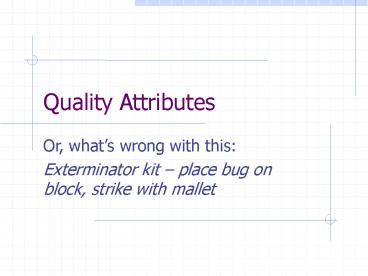Quality Attributes - PowerPoint PPT Presentation
Title:
Quality Attributes
Description:
Quality Attributes Or, what s wrong with this: Exterminator kit place bug on block, strike with mallet Functionality vs Quality Attributes Some Qualities ... – PowerPoint PPT presentation
Number of Views:465
Avg rating:3.0/5.0
Title: Quality Attributes
1
Quality Attributes
- Or, whats wrong with this
- Exterminator kit place bug on block, strike
with mallet
2
Functionality vs Quality Attributes
Quality
Functionality
3
Some Qualities
- Usability
- Modifiability
- Performance
- Security
- Testability
- Availability
- Time to market
- Cost and benefit
- Projected System lifetime
- Targeted Market
- Rollout Schedule
- Integration / Legacy
4
Architectural Qualities
- Conceptual Integrity
- Correctness and Completeness
- Buildability
5
Qualities Trade-offs
- The qualities are all good
- The qualities value is project specific
- The qualities are not independent
6
Quality Attribute Scenarios
- Source of stimulus
- Stimulus
- Environment
- Artifact
- Response
- Response measure
- (see inside front cover)
In the environment, the source throws the
stimulus and hits the system in the artifact
7
Example from cars
Response Measure Deflection lt N Noise lt M dB
Artifact Tires
Stimulus Bumps
Environment Highway driving
Source of stimulus Road
Response Control maintained Smooth ride Low noise
8
Remember
- One stimulus per scenario
- One environment per scenario
- One artifact per scenario
- Multiple response measures are OK
9
Example from software
Response Measure No unauthorized users, login lt
1 min
Artifact User interface
Stimulus Dozens of simultaneous logins
Environment Normal operation
Response Security maintained Acceptable delays
Source of stimulus Shift change
10
If you remember one thing
- To be effective, quality attribute scenarios must
be testable - (just like any other requirement)
- Therefore, the
- Stimulus
- Artifact
- Environment
- Response measure(s)
- must be clear and specific
11
Activity define quality attribute scenarios
12
Next step
- Assume some of the critical quality attribute
scenarios have been defined - What next?
13
Tactics how to accomplish a quality attribute
scenario
- Air-filled tires
- Big old springs
- Shock absorbers
- (Im no auto engineer)
14
Tactics for shift change
- Separate authenticationauthorization from
environment setup - Show progress indicator(s)
- Precompute expensive structures
- Defer at-login-time processing to background
- Thin clients shared services
- Deploy workstations
- Minimize other load on the system at shift change
times - What BCK tactics are these? (refer to handout)
15
Tactics for Qualities
- Tactics are a guide to design!
- Tactics are design choices oriented toward
achieving qualities - Tactics can refine other tactics
- Patterns package tactics
- Tactics can interfere!
- Next week a way to use quality attribute
scenarios and tactics to drive module
decomposition
16
Tactics are ways to get the desired response in a
scenario
Tactic
Artifact
Response
Stimulus
Environment
17
Tactics example performance
Introduce concurrency
Max delay lt 2 sec
Database
Prompt results
25 req/sec
Normal ops
18
Qualities categorize tactics
Fault Masked or Repair Made or Fault
Detected (not enough by itself)
Availability
Fault
19
Availability
Recovery Prep and Repeat
Recovery- Reintroduction
Fault Detection
Prevention
Removal from service Transactions Process
Monitor
Voting Active Redundancy Passive
Redundancy Spare
Shadow State ReSync Rollback
Echo Ping Exception
20
Tactics can interfere with each other
- Modifiability use an intermediary
- Performance reduce computational overhead
- Modifiability/Performance conflicts are common
21
Patterns package tactics
- An architectural pattern usually applies a set of
compatible tactics - Better yet, mutually reinforcing tactics
- Or at least, the pattern may give advice on
balancing tactics that tend to conflict
22
Example 1 tactics in Money (488)
- This is one of Fowlers Base Patterns
- Modifiability tactics used include
- m1. Semantic coherence
- m2. Anticipate changes
- m3. Generalize module
- m5. Abstract common services
23
Example 2 Reactor includes
- Modifiability
- m3. Generalize module
- m5. Abstract common services
- m6. Hide information
- Performance
- p3. Manage event rate
- p2. Reduce computational overhead
- p5. Introduce concurrency
- p8. Scheduling policy
24
Styles
- Styles (Shaw and Garlan) are recurring partial
architectures - Styles are sometimes also called patterns
- Like patterns, they package tactics
- But theyre not usually linked with a problem
- A style consists of
- Set of element types
- Element topology
- Set of semantic constraints
- Set of interaction mechanisms
25
Style example pipes and filters
- Tactics include
- m2. anticipate expected changes
- m5. abstract common services
- m6. hide information
- m7. maintain existing interface
- m8. restrict communication paths
- m12. polymorphism
- m13. component replacement
- p3. manage event rate
26
Style example Service-Oriented Architecture (SOA)
- Tactics include
- m2. anticipate expected changes
- m5. abstract common services
- m6. hide information
- m7. maintain existing interface
- m8. restrict communication paths
- m12. polymorphism
- m13. component replacement
- m14. adherence to defined protocols
- t2. separate interface from implementation
app
app
service
service
service
service
27
Tools of the architects trade
- Quality attribute scenarios
- A way of defining testable quality requirements
- Tactics
- Bags of tricks you can apply
- Patterns and styles
- Sets of tactics that usually fit together well
and are often applied together






























